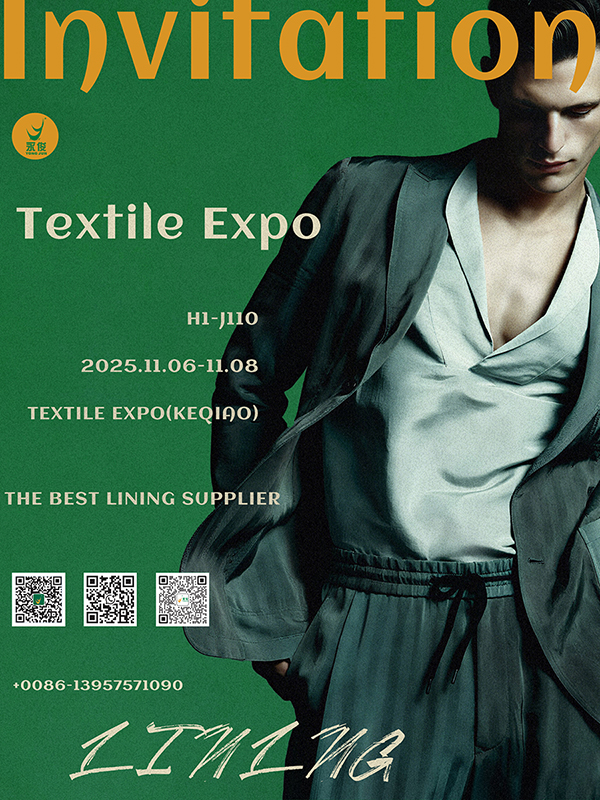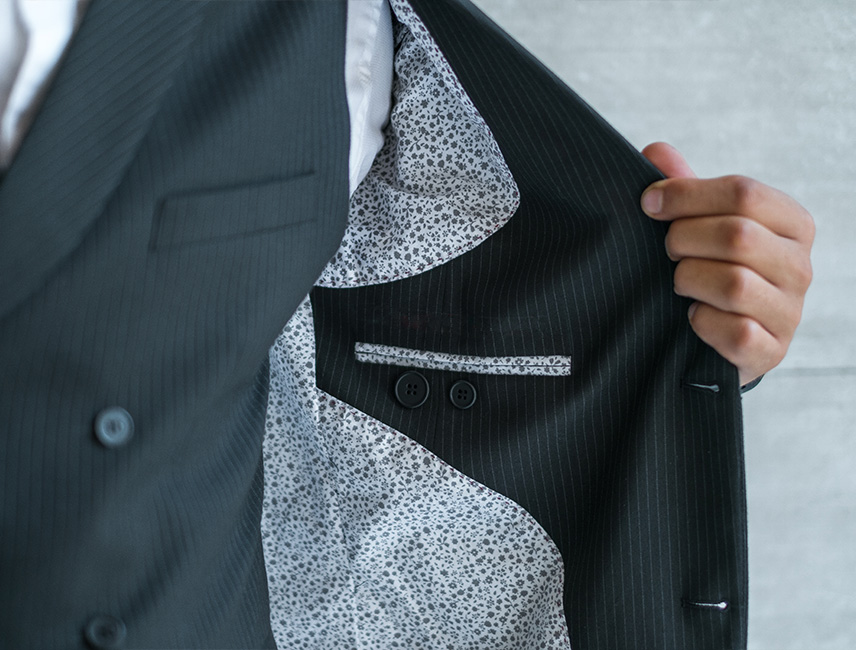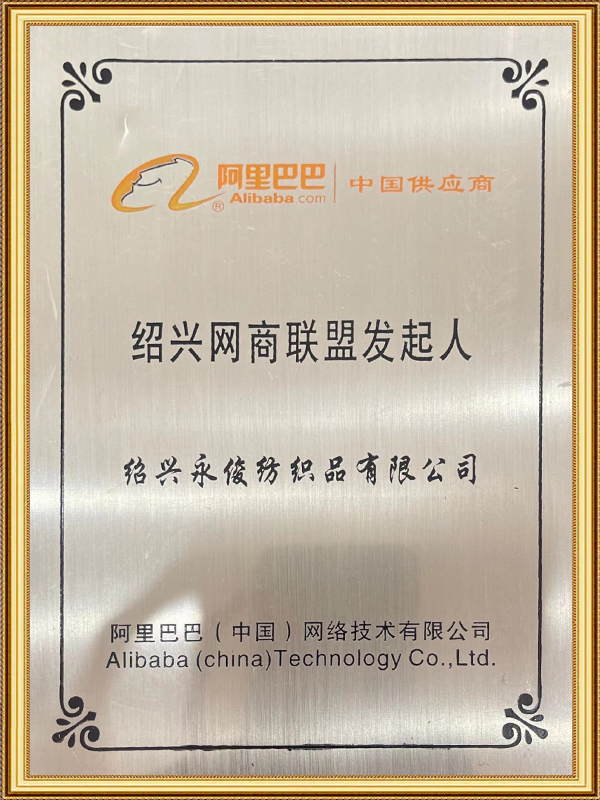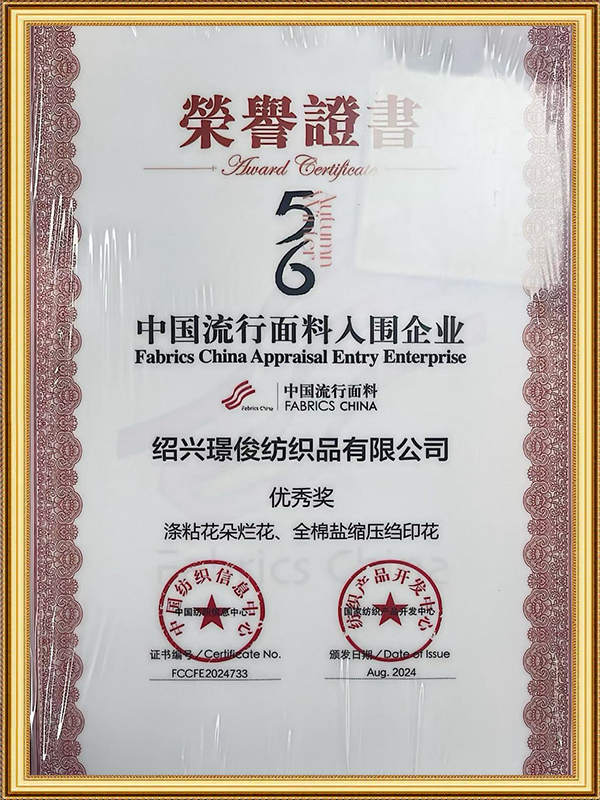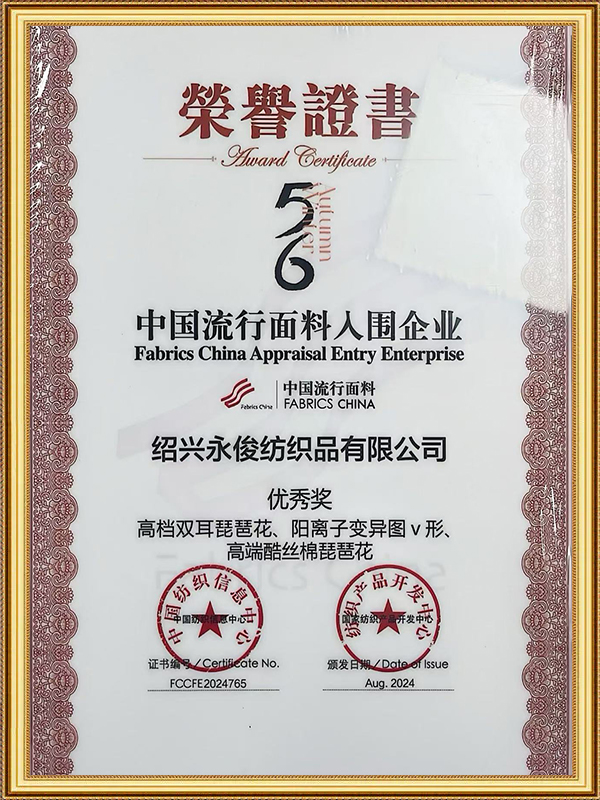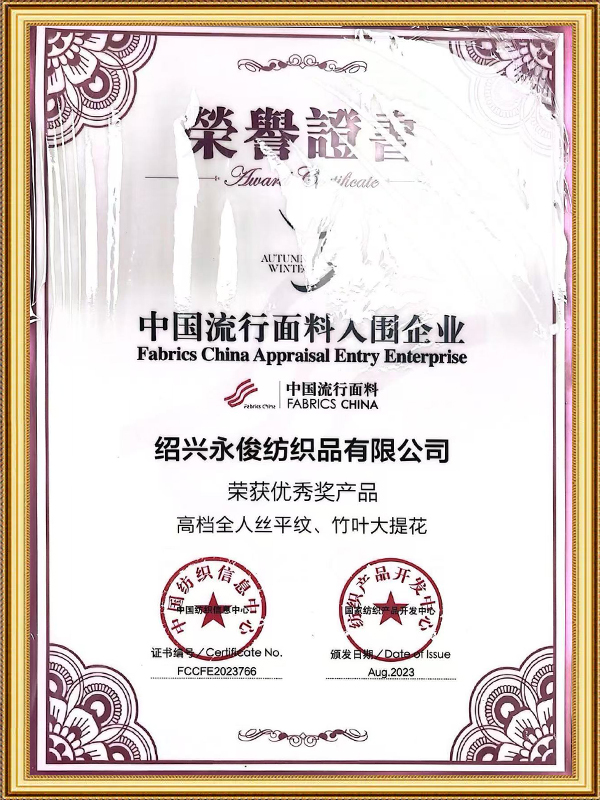Which type of Polyester Filament Yarn is typically used for PV Dobby lining
PV Dobby lining (Polyester Viscose Dobby lining) is widely used in the field of high-end garment lining due to its elegant texture, excellent drape, and durability, making it suitable for the lining of suits, coats, jackets, and gowns. Shaoxing Yongjun Textile Co., Ltd. has specialized in lining research and development and production for many years, and its professional team has deep knowledge of the performance and weaving characteristics of polyester fibers, providing customers with high-quality, high-performance dobby lining solutions.
Firstly, the polyester fiber primarily used in PV Dobby lining is Polyester Filament Yarn (PFY). The continuity and uniformity of the filament yarn ensure that the woven dobby texture is clear and three-dimensional, while also guaranteeing the fabric's stability in subsequent processes such as dyeing, coating, embossing, and calendering. Compared to spun polyester or poly-cotton blends, filament polyester exhibits a lower pilling rate and better luster, which is essential for the visual and tactile experience of garment lining. Yongjun Textile strictly selects high-quality polyester filament yarns that have undergone combing and drawing processes to produce PV Dobby lining, ensuring the lining possesses both a soft hand-feel and maintains crispness and durability.
Secondly, the specifications and twist of the polyester filament yarn are important factors affecting the performance of PV Dobby lining. Typically, Yongjun Textile selects different specifications of polyester filament yarn based on the lining's intended use. For instance, for high-grade PV Dobby lining used in suits, finer filament fibers (around 75-100D) are often used to enhance the fabric's drape and comfort; whereas for lining used in casual wear such as coats or jackets, slightly coarser filament fibers (around 150D) may be chosen to improve abrasion resistance and tear strength. By rationally configuring the fiber specifications, the company can offer customized products to meet diverse customer needs, ensuring the lining fulfills both design requirements and wear durability.
In addition to the fiber choice itself, the spinning process of the polyester filament yarn is key to ensuring the quality of PV Dobby lining. Shaoxing Yongjun Textile Co., Ltd. collaborates with multiple premium suppliers, selecting high-modulus, low-shrinkage polyester filament yarn. Through precise control of yarn twist, tension, and the dyeing and finishing process, they achieve uniformity in the dobby texture and stability in color. This not only enhances the aesthetic appeal of the lining but also strengthens its performance after repeated washing and dry cleaning. Particularly in business attire, the lining's crispness, smoothness, and durability directly impact the overall quality of the finished garment, and the application of high-quality polyester filament yarn meets precisely this demand.
Furthermore, the use of polyester filament yarn in PV Dobby lining offers excellent functional extensibility. Yongjun Textile can incorporate anti-wrinkle, anti-static, breathable, and anti-stain functional finishes while maintaining the fundamental fiber properties, meeting the individualized demands of various markets and brands. The company has accumulated rich experience in polyester fiber selection and finishing processes, ensuring that every batch of lining meets stringent standards in colorfastness, hand-feel, and texture reproduction.
What are the limitations or considerations for post-finishing processes like embossing, coating, and calendering on PV Dobby lining
PV Dobby lining (Polyester Viscose Dobby lining), with its unique three-dimensional texture, good drape, and durability, is widely used as a lining for high-end garments such as suits, coats, gowns, etc. As the demand for garment design diversification and functionalization increases, post-finishing processes such as embossing, coating, and calendering have become essential means to enhance the lining's aesthetic appeal and functionality. However, when these processes are applied to PV Dobby lining, certain limitations and considerations exist, which require professional teams to scientifically control. Shaoxing Yongjun Textile Co., Ltd., with over two decades of industry experience and advanced technology, has accumulated rich practical experience in this area, enabling it to provide customers with high-quality, high-performance lining products while ensuring the feasibility and effect stability of post-finishing.
Firstly, the embossing process involves forming a relief pattern on the fabric surface through heat pressing or mechanical pressure, making the lining richer in both visual and tactile experience. When applied to PV Dobby lining, attention must be paid to the thermal sensitivity of the polyester fiber. Excessive heat pressing temperature or overly long pressing time can lead to fiber deformation, setting of wrinkles, or even surface melting, thereby damaging the original dobby texture. Yongjun Textile, when producing PV Dobby lining, strictly selects high-melting-point, high-strength polyester filament yarn and controls yarn density and weaving tightness to ensure the fabric can withstand high temperature and pressure during embossing while maintaining a clear and three-dimensional pattern. Through this optimized design, the company ensures that the embossing process achieves the desired decorative effect without compromising the structural stability of the lining.
Secondly, the coating process is used to impart functional characteristics to the lining, such as water resistance, stain resistance, oil repellency, or increased surface gloss. When coating PV Dobby lining, the absorbency and stretch properties of the polyester fiber need to be considered. If the coating liquid penetration is uneven or the coating thickness is excessive, it may lead to surface hardening, a stiff hand-feel, or even diminish the three-dimensional effect of the dobby texture. Yongjun Textile possesses advanced coating equipment and a precise process parameter control system, allowing for uniform coating while maintaining the lining's softness and smoothness. This ensures that when customers choose PV Dobby lining for functional purposes, they meet both visual and tactile requirements, as well as protection performance and comfort.
Thirdly, the calendering process is used to enhance the lining's luster and upscale feel, but its application on PV Dobby lining poses certain technical challenges. Polyester dobby fabrics are prone to uneven gloss, localized shine, or unclear dobby textures during high-temperature calendering. Targeting this characteristic, Yongjun Textile precisely adjusts the calendering temperature, roller pressure, and speed to ensure the fabric surface has a natural and uniform luster while protecting the integrity of the dobby structure. The company's R&D team, drawing on years of practical experience, can also develop personalized calendering solutions for PV Dobby lining of different thicknesses and patterns, ensuring the final product possesses both a high-grade luster and retains the elegant three-dimensional pattern.
Furthermore, when PV Dobby lining undergoes multiple superimposed processes, special attention must be paid to the process sequence and their mutual interaction. For example, embossing followed by calendering, or coating followed by embossing, can all have different effects on the fabric hand-feel and the clarity of the dobby. Shaoxing Yongjun Textile Co., Ltd. has established a rigorous process flow control system and quality monitoring standards during production, ensuring that every step of the processing is scientifically controllable. Detailed specifications are provided for everything from raw material selection and weaving density to post-finishing process parameters, to minimize process risks and improve product consistency.
What dyes are commonly used for dyeing PV Dobby lining
PV Dobby lining (Polyester Viscose Dobby lining), as a high-end garment lining, combines aesthetic appeal, durability, and functionality, making it an ideal choice for the lining of suits, coats, jackets, and gowns. During the production process, the dyeing technology plays a crucial role in the lining's color presentation, hand-feel, durability, and market competitiveness. Shaoxing Yongjun Textile Co., Ltd., with over two decades of experience in lining R&D and production, has deeply cultivated polyester dobby lining dyeing technology, enabling it to provide customers with diverse, high-quality dyeing solutions and ensuring PV Dobby lining's advantages in both aesthetics and performance.
In the dyeing of PV Dobby lining, Disperse dyes are the most commonly used type of dye. Since polyester fiber is a highly crystalline and hydrophobic synthetic fiber, ordinary reactive dyes are difficult to use for direct coloring. Disperse dyes, however, can penetrate the fiber interior under high-temperature and high-pressure conditions, achieving full, vibrant color with excellent fastness. Yongjun Textile utilizes advanced dyeing equipment and precise temperature control processes in the application of disperse dyes to achieve uniform, brilliant coloration without compromising the three-dimensional effect of the dobby texture. Concurrently, the company can flexibly adjust dyeing concentration and process parameters according to different customer needs to meet the personalized color requirements of suits, gowns, or functional apparel.
In addition to disperse dyes, Reactive dyes and Acid dyes are also often selected for poly-cotton blended PV Dobby lining. Reactive dyes chemically bond with cotton fibers, achieving high colorfastness and a soft hand-feel; acid dyes are suitable for blended linings containing small amounts of nylon or rayon, providing a delicate, uniform color layering to the fabric. Shaoxing Yongjun Textile Co., Ltd. utilizes scientific formulations and process optimization to rationally combine these dyes with polyester disperse dyes, ensuring that blended linings maintain overall color uniformity while preserving the comfort of the fibers and the clarity of the dobby structure.
During the dyeing process, colorfastness is a key indicator of customer concern. PV Dobby lining is often used for high-end business and formal wear lining and must withstand dry cleaning, daily washing, and friction without fading. Yongjun Textile incorporates advanced setting treatments and post-finishing processes in its dyeing, including high-temperature setting, catalyst-assisted dyeing, and surface finishing techniques, to ensure that every batch of lining meets strict international standards for wash, perspiration, light, and friction fastness. This not only guarantees the long-term aesthetic appeal of the finished garment during use but also reflects the company's professional advantage and technical strength in dyeing technology.
Which types of coats or suits are most suitable for using PV Dobby lining
PV Dobby lining (Polyester Viscose Dobby lining), with its unique three-dimensional texture, smooth hand-feel, excellent drape, and durability, is a premium choice for garment lining. Shaoxing Yongjun Textile Co., Ltd. has specialized in lining R&D and production for many years. Through scientific raw material selection and exquisite craftsmanship, the PV Dobby lining not only meets the aesthetic needs of designers and brand clients but also excels in functionality and durability.
Firstly, high-end suits and business formal coats are the most typical application scenarios for PV Dobby lining. High-end suits typically require linings to possess a smooth hand-feel, elegant luster, and a crisp structure to ensure comfortable wear, smooth donning and doffing, and to not compromise the overall garment appearance. PV Dobby lining is woven from high-quality polyester filament yarn, which is uniform and highly three-dimensional, allowing the lining to form a natural drape inside the suit while supporting the outer fabric structure and preventing wrinkling from frequent friction. Shaoxing Yongjun Textile Co., Ltd. strictly controls yarn density and weaving precision during production, ensuring the dobby texture is clearly visible. Even in frequently used business suits, the lining maintains a neat, crisp look, enhancing the garment's quality.
Secondly, casual coats and jackets are also highly suitable for PV Dobby lining. Compared to formal suits, casual coats and jackets require higher resistance to abrasion and better durability from the lining, while still retaining a comfortable, soft feel. The high-strength polyester filament yarn selected by Yongjun Textile ensures that PV Dobby lining retains its original structure and pattern when subjected to repeated donning, doffing, and friction, resisting pilling, snagging, or wrinkle deformation. Furthermore, the diverse post-finishing processes provided by the company, such as embossing, coating, and anti-wrinkle treatment, make the lining not only aesthetically pleasing but also offer protective and functional advantages, meeting the dual demand for durability and comfort in casual wear.
In addition, gowns and evening coats are ideal for PV Dobby lining. In gown design, the lining not only provides structural support but also directly influences the garment's overall aesthetic. PV Dobby lining's unique dobby texture and natural luster, can maintain the fabric's drape, while adding a delicate, decorative element to the interior of the gown. The R&D team at Shaoxing Yongjun Textile Co., Ltd. carefully optimizes fiber selection, weaving, and dyeing to ensure the lining maintains a clear pattern and uniform color through various post-finishing processes (such as calendering, hot stamping, lamination), providing an elegant, premium lining effect for high-end gowns.
Notably, PV Dobby lining is also very suitable for functional outerwear, such as windproof, lightweight outdoor jackets or business coats with water-repellent features. Polyester fiber inherently possesses good moisture resistance and wrinkle resistance. After undergoing embossing, coating, and water-repellent finishing, the lining not only retains a soft hand-feel but also enhances the overall durability and functionality of the fabric.

 English
English 中文简体
中文简体